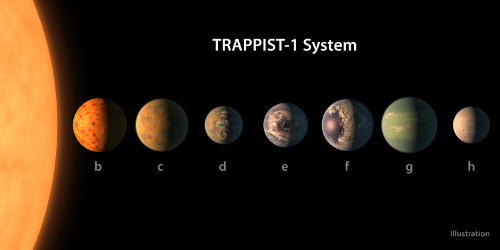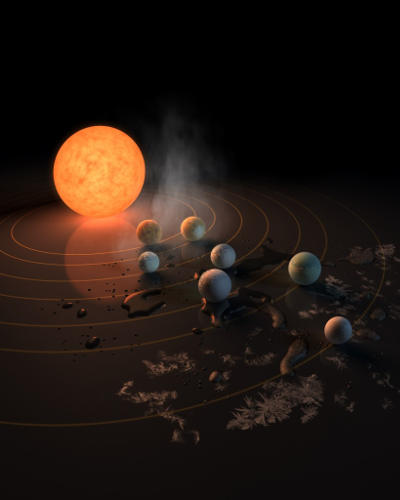Digital wellbeing should be a public health priority for the Arab region
21 October 2025
Published online 22 February 2017
A second Earth is not just a matter of if but when, scientists say.

© NASA/JPL-Caltech
"The discovery gives us a hint that finding a second earth is not just a matter of if but when," says Thomas Zurbuchen, from NASA’s Science Mission Directorate in Washington DC,"What we have is a major step forward to answering the question – are we alone out there?"
The star is known as TRAPPIST-1 and the discovery of its seven orbiting planets is the result of more than a thousand hours of observation by astronomers from ground-based telescopes in Chile, Morocco, Hawaii, Canary Islands, Liverpool and South Africa and 20 days of continuous surveillance from NASA’s Spitzer Space Telescope.
“This is the first time that so many planets of this kind are found around the same star. They form a very compact system - the planets being both close to each other and close to the star, which is reminiscent of the system of the moons around Jupiter,” says astrophysicist Michael Gillon, at the University of the Liege's Space Sciences, Technologies and Astrophysics Research (STAR) Institute, Belgium.
Using a technique called transit photometry, Gillon and his team capture information about a planet by measuring the amount of light it blocks as it moves in front of its host star. At La Silla Observatory in the Chilean desert, these scientists began monitoring nearby stars six years ago using a dedicated 60cm robotic telescope––The Transiting Planets and Planetesimals Small Telescope (TRAPPIST)––from which the newly discovered planet system now derives its name. Its twin, at Oukaïmeden Observatory in Morocco, was developed more recently to cover the northern as well as southern hemisphere.
Last year, the team discovered three planets, but anomalies in the calculations led them back to the drawing board. Results from the monitoring campaign that followed, published today in Nature, show 34 clear passes in front of the star, which can be attributed to seven different planets. The final planet was captured passing only once.

© NASA/JPL-Caltech
Detailed information about their chemical and atmospheric composition will come from the Hubble space telescope, the James Webb telescope to be launched in 2018 and other instruments over the next months and years.
It’s possible that these planets could have atmospheres like that on Earth or Venus “or maybe something completely different,” says Gillon.
Key indicators of life include the combination of methane, oxygen, ozone, or carbon dioxide. The most promising of all seven is TRAPPIST-1 (f), in the middle of the system, which is slightly cooler than the Earth, but with the right atmosphere and enough greenhouse gases should still be habitable, say researchers. TRAPPIST (e) and (g) are also strong candidates for life.
The hope is that life, if present, will be determined within a decade.
“We have made a crucial step towards finding if there is life out there,” says Amaury Triaud from Cambridge University’s Institute of Astronomy. “Here, if life managed to thrive and releases gases similar to that on Earth, we will know."
The star system presents a unique opportunity to compare and contrast conditions between the seven planets to understand how life emerges because the planets are both close to each other and orderly.
With the exception of the unknown seventh, the system forms ‘a chain of resonance’ in which each planet orbits in sync with the others––where the first innermost planet makes eight orbits, the second makes five, the third three and fourth two orbits.
This may also mean that unlike our solar system, the TRAPPIST-1 system is tidally locked––the same side of the planets always faces the star or away from the star so there's permanent day on one side, permanent night on the other.
According to Gillon, physical theory shows that an atmosphere similar to the Earth, even if it is less dense, would still able to transport the heat from the day to the night side. So even though it would be colder, the thermal gradient would not mean that life was impossible.
"This discovery allows us to stop thinking that we are the centre of the universe."
Small stars are good targets for finding Earth-sized planets, because a significant proportion of their light is blocked when they pass across the face of the star.
It may therefore be relatively easy to find many more such planets in the future. “Nobody was looking at these tiny cool stars before,” says Emmanuel Jehin, co-author at STAR. “It looks like they are producing a lot of small planets. Here, with only one star [TRAPPIST-1] we have plenty of Earth-like planets.”
Indications are that 30-50% of these cool dwarf stars could have planets like the TRAPPIST-1 system. And because those stars represent the majority of the galaxy, that’s large, says Triaud.
The TRAPPIST-1 survey is part of a more ambitious project, SPECULOOS, which aims to search for Earth-sized planets in the nearest 1000 ultra-cool stars and red dwarfs in the next 10 years. The core of the project is a new SPECULOOS Southern Observatory composed of four 1m-diameter telescopes equipped with cameras very sensitive in the near-infrared, the wavelength range in which ultra-cool stars and brown dwarfs emit most of their light. These telescopes are currently being built at the Paranal Observatory, Chile.
The two TRAPPIST 60cm robotic telescopes at La Silla Observatory Chile and Oukaïmeden Observatory in Morocco, will also participate in the project.
The result of all this work is humbling. There is a lot of potential out there—life may not be exclusive to Earth.
“This discovery allows us to stop thinking that we are the centre of the universe: if your form of life exists someplace else, it means that there is not one single point of creation, which is very important from a philosophical point of view. From a scientific point of view, [the value of the research] is in all the different methods that have evolved to …discover these new worlds,” says Benkhaldoun Zouhair, director of the Oukaïmeden Observatory, Cadi Ayyad University in Morocco and co-author of the study.
Most important, according to Triaud, is that today we have the opportunity to investigate these planets, their atmospheres and potential for life and we can do so using the current tools and techniques already in development. “If there is life, that’s good because we didn’t wait too long. If there isn’t, then we have learned something quite deep about where life can emerge."
doi:10.1038/nmiddleeast.2017.37
Stay connected: